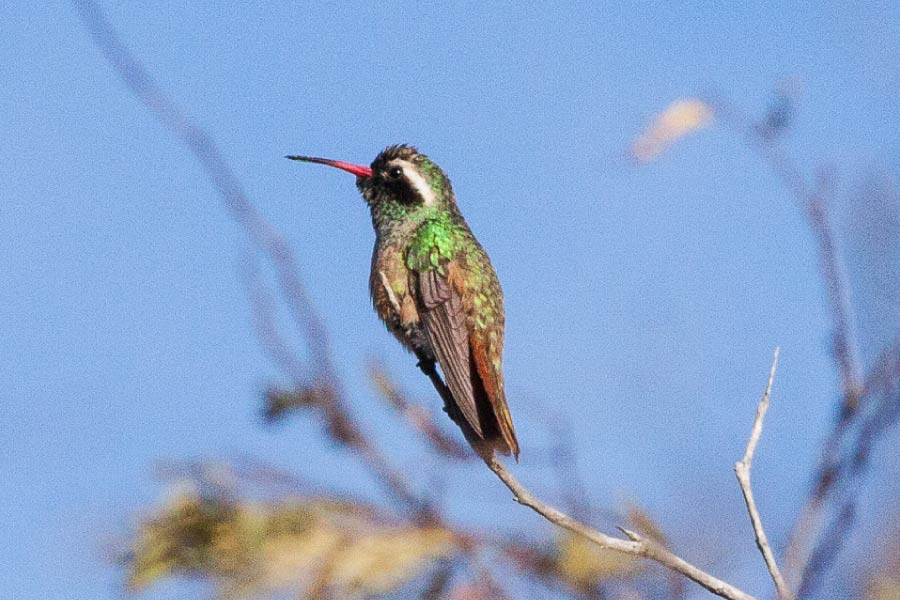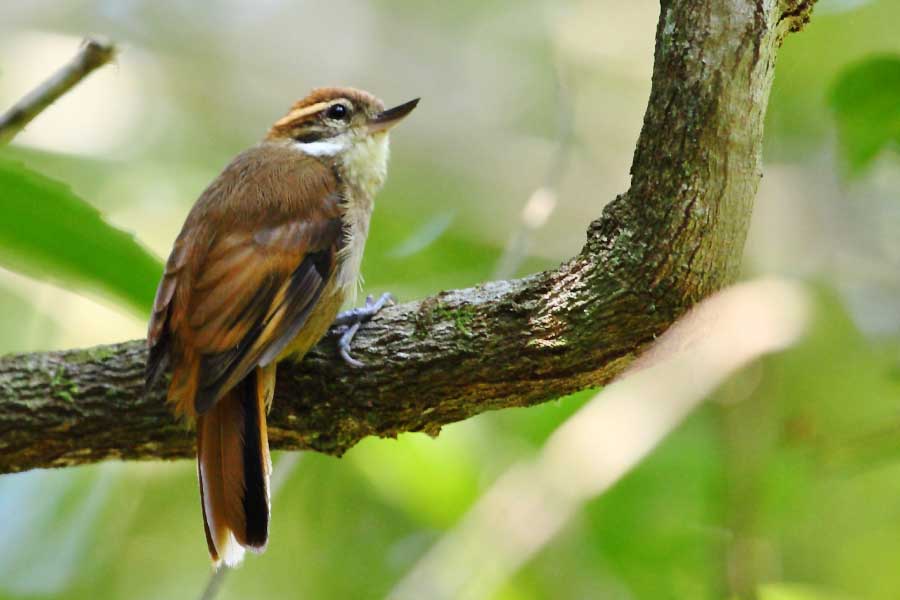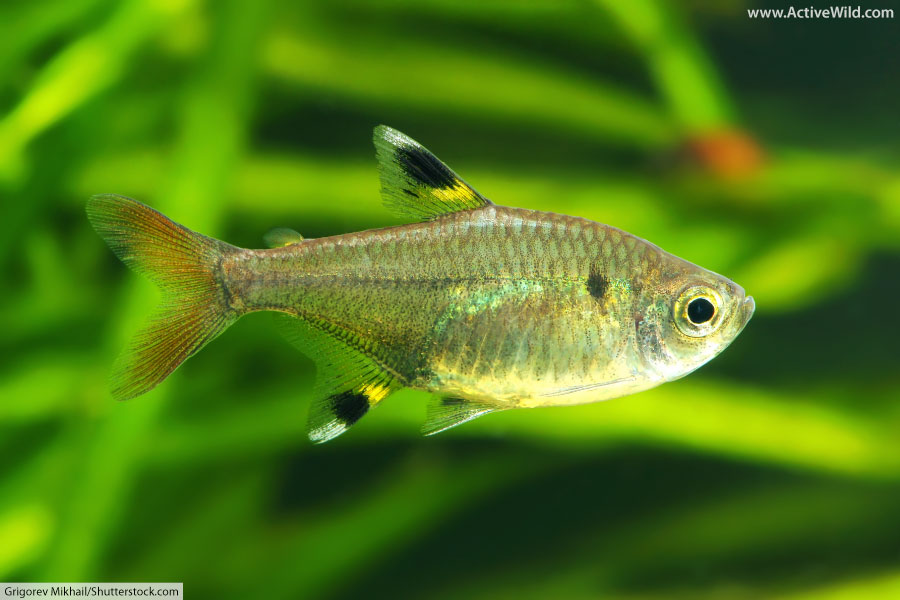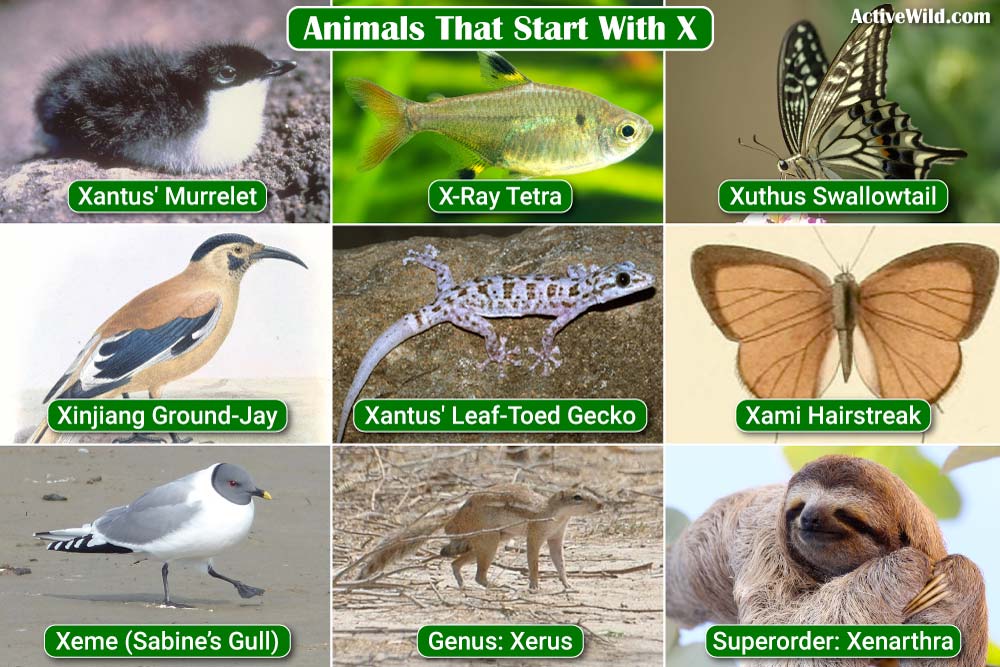Animals that start with X include: mammals such as Xanthippe's shrew and the xolo (a breed of dog); the reptile Xantus' leaf-toed gecko (a species of lizard); fish such as the X-ray tetra and xestus sabretooth blenny; and birds such as Xantus' Hummingbird and the xeme.
On this page are pictures and facts on these and other animals beginning with X. Included in this list are individual species (e.g. X-ray tetra) and groups of species (e.g. the genus Xenops) whose names begin with X.
The scientific name and conservation status (where known) are provided for each of the individual species.
Use the index below to find information on an animal. Use the "Back to animal list" links to return to the index and search for another animal.
Animals That Start With X
- Xami Hairstreak
- Xanthippe's Shrew
- Xanthic Sargo
- Xantus' Hummingbird
- Xantus' Leaf-Toed Gecko (Leaf-Toed Gecko)
- Xantus' Murrelet
- Xantus' Swimming Crab
- Xantusia (genus)
- Xavier's Greenbul
- Xeme (Sabine's gull)
- Xenarthra (superorder)
- Xenops (genus)
- Xenopus (genus)
- Xerus (genus)
- Xestus Sabretooth Blenny
- Xingu Corydoras
- Xingu River Ray
- Xinjiang Ground-Jay (Biddulph's Ground Jay)
- Xolmis (genus)
- Xolo / Xoloitzcuintle
- X-Ray Tetra
- Xucaneb Robber Frog
- Xuthus Swallowtail (Asian Swallowtail)
Discover More Animals
Find more animals by clicking on the letters below!



























Xami Hairstreak

- Scientific name: Callophrys xami
- Type of animal: Butterfly
- Where found: USA, Mexico, Central America
- Conservation status: Unassessed
Callophrys xami is a rare species of butterfly also known as the “xami hairstreak” or “green hairstreak”. It is a member of the family Lycaenidae – the world's second-largest butterfly family (in terms of species diversity), after Nymphalidae (“brush-footed butterflies”).
Members of the family Lycaenidae are also known as “gossamer-winged butterflies”.
The xami hairstreak belongs to the subfamily Theclinae, a group of butterflies known as “hairstreaks” due the hair-like markings present on the undersides of the hindwings of many species in this group.
Xanthippe's Shrew

- Scientific name: Crocidura xantippe
- Type of animal: Mammal
- Where found: Africa
- Conservation status: Least Concern
Xanthippe's shrew is a small species of shrew found in Kenya and Tanzania in eastern Africa. It lives in dry savanna and shrubland habitats and is present in the foothills of Tanzania’s Usambara Mountains.
Xanthippe's shrew is one of around 376 shrews. These small mammals make up the family Soricidae. Despite resembling animals such as mice and voles, shrews are not rodents. Instead, they belong to the order Eulipotyphla, a group of animals that also contains moles and hedgehogs.
Xanthic Sargo
(No photo available)
- Scientific name: Anisotremus davidsonii
- Type of animal: Fish
- Where found:
- Conservation status: Least Concern
The Xanthic sargo is a fish found on the Pacific coasts of the United States and Mexico. It belongs to the family Haemulidae, a group of fish also known as “grunts” on behalf of the sounds they make by grinding their teeth.
Xantus' Hummingbird

- Scientific name: Basilinna xantusii
- Type of animal: Bird
- Where found: Mexico
- Conservation status: Least Concern
Xantus' hummingbird is a mid-sized hummingbird found only in Baja California, (a state in north-west Mexico). Like several species in this list of animals that start with X, Xantus' hummingbird was named after John Xantus de Vesey, a Hungarian zoologist.
Xantus' hummingbird is mainly green in color, and has black cheeks and a bright white stripe behind each eye. Its calls are loud and metallic. It uses its long bill and extendable tongue to obtain nectar from flowers.
There are around 360 hummingbird species. The unique wing structure of hummingbirds means that they are able to hover. While doing so, their wings beat fast enough to produce a humming sound.
You can find out more about this species on this page: Xantus' Hummingbird Facts
Xantus' Leaf-Toed Gecko (Leaf-Toed Gecko)

- Scientific name: Phyllodactylus xanti
- Type of animal: Reptile
- Where found: U.S.A., Mexico
- Conservation status: Least Concern
The leaf-toed gecko is also known as Xantus’ leaf-toed gecko to commemorate the Hungarian naturalist, John Xantus.
Geckos are lizards belonging to the infraorder Gekkota. Unlike other lizards, they have vocal cords, and are able to makes sounds such as chirps, clicks and hisses.
Another characteristic of (most) geckos is their lack of eyelids. Because they are unable to blink; geckos clean their eyes by licking them with their tongues.
Xantus’ leaf-toed gecko is found in southern California, Baja California, Mexico, and on nearby islands. Those found on Raza Island are known as “Raza Island leaf-toed geckos”.
Xantus' Murrelet

- Scientific name: See text
- Type of animal: Bird
- Where found: North America
- Conservation status: Scripps's murrelet: Vulnerable; Guadalupe murrelet: Endangered
The species previously known as Xantus' Murrelet was split into two species–Scripps's murrelet (Synthliboramphus scrippsi) and the Guadalupe murrelet (Synthliboramphus hypoleucus)–in 2012.
Both species are found off the western coast of North America, from British Columbia, Canada, south to the Baja Peninsula, Mexico.
Murrelets are small seabirds in the auk family, Alcidae. Other members of the family include puffins and guillemots.
Xantus' Swimming Crab

- Scientific name: Portunus xantusii
- Type of animal: Crustacean
Xantus' swimming crab is a species of crab in the family Portunidae. Species in this family have flattened hind legs, which they use as oars while swimming.
Like many other animals in this list of animals that start with X, Xantus' swimming crab is named after the Hungarian naturalist John Xantus.
Xantusia (Genus)

- Type of animal: Reptiles
- Where found: North America
Xantusia is a genus, rather than a species beginning with X. A genus is a group of closely-related animals (for example, the genus Pan contains the chimpanzee and the bonobo).
Xantusia is part of the Night lizard family, Xantusiidae. This group of small lizards, many of which give birth to live young rather than laying eggs, is found in southern North America, Central America, and nearby islands.
Xavier's Greenbul
(No photo available)
- Scientific name: Phyllastrephus xavieri
- Type of animal: Bird
- Where found: Africa
- Conservation status: Least Concern
Xavier's greenbul is a bird found in tropical forests in central Africa. It is olive-green with brown wings. It is one of around 150 species in the family Pycnonotidae.
Pycnonotidae is part of a larger group of birds, Passeriformes, whose members are known as “songbirds” or “perching birds”.
Xeme (Sabine's gull)

- Scientific name: Xema sabini
- Type of animal: Bird
- Where found: Eurasia, North America, Africa
- Conservation status: Least Concern
Sabine’s gull is a species of seabird also known as the “xeme” (hence it’s appearance in this list of animals that start with X). It is a member of the family Laridae. As well as gulls, this family also includes terns and skimmers.
Sabine’s gull breeds on the Arctic tundra of North America and northern Eurasia. The species migrates great distances, and outside of its summer breeding season may be seen off the coasts of Africa, the Americas, and Eurasia.
Xenarthra (Superorder)

- Type of animal: Mammals
- Where found: North and South America
There aren’t many animals that start with X, so we’ve included the superorder Xenarthra, the group of mammals that contains anteaters, sloths and armadillos. The Catalogue of Life (an online database of species) currently recognizes 37 species in this group. (Source)
Xenarthra means “strange joints”. The name refers to the unique joints of the spinal cords of members of the group.
Another characteristic of xenarthrans (members of Xenarthra) is a low metabolism, which means that their bodies don’t use a lot of energy. As a result, xenarthrans are generally, slow-moving, rather docile animals
Xenarthrans are only found in the Americas. Well-known examples include the giant anteater, nine-banded armadillo, and brown-throated sloth.
You can find out more about Xenarthra on this page: Xenarthra Facts
You can find out more about sloths on this page: Sloth Facts
You can find out more about anteaters on this page: Anteater Facts
Xenops (Genus)

- Type of animal: Bird
- Where found: Mexico, Central and South America
Xenops is not a species; it's a genus (a group of related species) of birds in the ovenbird family, Furnariidae. There are three species of genus Xenops: the slender-billed xenops, plain xenops, and streaked xenops.
Found in Mexico, Central and South America, the Xenops are small brown birds that hop up and down tree trunks foraging for insects.
You can find out more about Xenops on this page: Xenops Facts
Xenopus (Genus)

Xenopus is a genus of frog found in sub-Saharan Africa (i.e. the portion of Africa south of the Saharan Desert). The genus contains 29 species, including Xenopus amieti (the volcano clawed frog), Xenopus laevis (the African clawed frog) and Xenopus tropicalis (the western, or tropical clawed frog).
Frogs of genus Xenopus are typically quite flat-bodied, and have a coating of protective slime. Like several frog species, Xenopus species burrow into the mud and enter a state of dormancy known as Aestivation during dry periods.
Xenopus species have three clawed toes on each foot. Several members of the group are known as “clawed frogs”.
Xerus (Genus)

- Type of animal: Rodent
- Where found: Africa
Xerus is a genus (a group of related species) of rodents in the squirrel family, Sciuridae. Species of genus Xerus are commonly called African ground squirrels.
Xerus contains four species: the striped ground squirrel, Cape ground squirrel, Damara ground squirrel, and unstriped ground squirrel. All are burrowing animals that live in a variety of habitats, including woodlands, grasslands and shrublands.
Like all rodents, African ground squirrels have a pair of sharp incisor teeth in both their upper and lower jaws which continue to grow throughout the animal’s lifetime. This allows the squirrels to gnaw on tough seeds, grains and roots without wearing their teeth out.
You can find out more about these animals on this page: African Ground Squirrel Facts
Xestus Sabretooth Blenny

- Scientific name: Petroscirtes xestus
- Type of animal: Fish
- Where found: Pacific Ocean, Indian Ocean
- Conservation status: Least Concern
Xestus sabretooth blenny is a small fish that lives on coral reefs in the Indian and Pacific Ocean. It is one of around 400 species in the family Blenniidae, whose members are known as “combtooth blennies”.
Like all blennies, the Xestus sabretooth blenny has a blunt head, large eyes, and a dorsal fin that extends the length of the back. Combtooth blennies are named for their comb-like teeth.
Xingu Corydoras
(No photo available)
- Scientific name: Xingu corydoras
- Type of animal: Fish
- Where found: South America
- Conservation status: Unassessed
Xingu Corydoras is a small freshwater fish found in Brazil’s Xingu River basin. A member of the “armored catfish” family Callichthyidae, it reaches a length of around 1.5 in. / 3.81 cm, and lives in small shoals.
Like other species of genus Corydoras, Xingu Corydoras is a popular aquarium fish.
Xingu River Ray

- Scientific name: Potamotrygon leopoldi
- Type of animal: Fish
- Where found: South America
- Conservation status: Data Deficient
The Xingu river ray is a freshwater stingray found in Brazil’s Xingu River basin. Other names for the species include “white-blotched river stingray”, and “polka-dot stingray”.
Being a stingray, the Xingu River ray’s tail is equipped with a venomous stinger. All rays belong to the superorder Batoidea and are closely related to sharks.
Xinjiang Ground-Jay (Biddulph's Ground Jay)

- Scientific name: Podoces biddulphi
- Type of animal: Bird
- Where found: Asia
- Conservation status: Near Threatened
The Xinjiang ground-jay (also known as the Biddulph's ground jay), is a small member of the crow family, Corvidae. It is found only in China, where it inhabits high-altitude desert and other arid habitats.
The species has a pale, sandy-brown plumage with darker markings on its head and face. It has a powerfully-built, curved beak for digging.
All four species of ground jays, although able to fly, rarely do so. Instead, they spend most of the time on the ground, and are capable runners and jumpers.
Xolmis (Genus)

- Type of animal: Bird
- Where found: South America
Xolmis is not an individual species, but a genus (a group of related animals). It contains two species: the white-rumped monjita Xolmis velatus and the white monjita Xolmis irupero.
Xolmis is part of the family Tyrannidae, a group of birds known as “tyrant flycatchers”.
Tyrannidae, whose members are found in both North and South America, is the largest family of birds, containing around 400 species.
Xolo / Xoloitzcuintle

- Scientific name: Canis lupus
- Type of animal: Mammal
- Where found: Originated in Mexico)
- Conservation status: Domestic
The Xoloitzcuintle, whose name is often shortened to “xolo”, is a breed of hairless dog. The breed is thought to have originated in Mexico, and may be over 3,000 years old. Sculptures of dogs resembling xolos have been found in several ancient burial sites.
The xolo is a breed of dog, rather than a species in its own right. All breeds of dogs (e.g., Alsatian, Border collie, Labrador, etc.) are the same subspecies: Canis lupus familiaris. (Some biologists argue that because the domestic dog
Canis lupus familiaris is a subspecies of grey wolf, Canis lupus, meaning that all domestic dogs are essentially wolves. (Some biologists now believe that the domestic dog should be treated as a separate species: Canis familiaris.
You can find out more about dogs on this page: Dog Facts
X-Ray Tetra

- Scientific name: Pristella maxillaris
- Type of animal: Fish
- Where found: South America
- Conservation status: Least Concern
The X-ray tetra is a small freshwater fish found in South America. It is present in both the Amazon and Orinoco river systems. The species is able to tolerate brackish water (i.e., water that is partly salty), and feeds on small insects and plankton.
The X-ray tetra gets its name due to its transparent skin, through which its internal organs and bones are visible.
You can find out more about this species on this page: X-Ray Tetra Facts
Xucaneb Robber Frog
(No photo available)
- Scientific name: Craugastor xucanebi
- Type of animal: Amphibian
- Where found: Central America
- Conservation status: Vulnerable
The Xucaneb robber frog is a species of frog found only in Guatemala in Central America. The species inhabits mountainous forests, living in bushes and undergrowth.
Like all species in the family Craugastoridae (whose members are known as “fishbelly frogs”), the Xucaneb robber frog is direct-developing. This means that it skips the tadpole stage of development, and instead hatches from the egg as a small frog.
Xuthus Swallowtail (Asian Swallowtail)

- Scientific name: Papilio xuthus
- Type of animal: Insect
- Where found: Asia
Xuthus swallowtail is an alternative name for the Asian swallowtail (another name for this species is the “Chinese yellow swallowtail”). It is a medium-large, yellow and black-winged butterfly that, like many other swallowtail butterflies of family Papilionidae, has a tail-like extension to each of its hindwings.
Xuthus swallowtail is a common species that is found in woodlands and other habitats in China, Japan, and other countries in southeastern Asia.
Discover More Animals
Find more animals by clicking on the letters below!






























We play a game in the car where someone says an animal and the next person has to name an animal starting with the last letter of the previous animal. Eg camel lion numbat tiger etc. We were stumped when ox and tyrannosaur rex came up as we couldn’t name an animal starting with X. Thanks
What about the “Xolo”? It’s a type of dog! Full name the Xoloitzcuintli. That’s what I use for X.
When I worked day care years ago I put an alphabet of animals together for the children. At the time, about 40 yrs ago now, there was an animal called an xanerous or something close to that spelling. It was similar to an amarillo. Do they exist anymore?
Hi Amy,
Thank you for your comment.
We assume that’s a typo and you mean an armadillo 🙂 In which case you’re right; armadillos belong to a group of animals known as Xenarthra. Other living xenarthrans include sloths and anteaters.
We hope this helps,
The Active Wild Team
There is another animal that starts with X called the Xenopus. It is a species of frog.
That’s a great call! We’ll add that to the list! 🙂
I work in a daycare . We are about to start our alphabet animal segment.
I was really struggling to find animals that began with “X” . This site really helped
me out . Thank you for helping me teach others about wildlife.
That’s great to hear – thank you so much for your comment! 🙂
Kind Regards,
The Active Wild Team